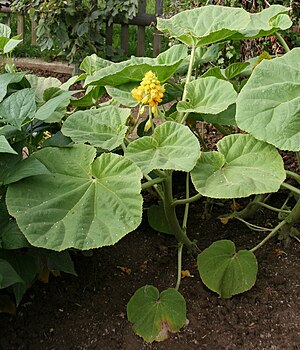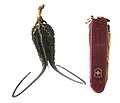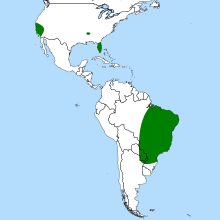Ibicella lutea
| Ibicella lutea | ||||||||||||
|---|---|---|---|---|---|---|---|---|---|---|---|---|

Ibicella lutea |
||||||||||||
| Systematics | ||||||||||||
|
||||||||||||
| Scientific name of the genus | ||||||||||||
| Ibicella | ||||||||||||
| Van Eselt. | ||||||||||||
| Scientific name of the species | ||||||||||||
| Ibicella lutea | ||||||||||||
| ( Lindl. ) Van Eselt. |
Ibicella lutea, also called the yellow unicorn plant or yellow devil's claw , is one of only two plant species of the genus Ibicella from the chamois horn family( Martyniaceae ). The German common name "Teufelskralle" is also used for other plant species and genera.
description
Vegetative characteristics
Ibicella lutea grows as an annual , herbaceous plant and reaches heights of 30–60 cm and spreads up to 5 m. Almost the entire plant is covered with sticky glandular hairs, which give off a clearly perceptible, sweet carrion odor . In addition, there are also glandless hairs on the plant. It forms a single, light green and strong stem .
The opposite or whorled, kidney- to heart-shaped, rounded leaves have long stalks (10–15 cm). The simple, toothed leaf blade with an average width of approx. 14-18 cm is sometimes shaped like a shell. The basal lobes are partly overlapping.
Inflorescence and flower
The flowers are in a long-stalked, terminal and dense racemose inflorescence. The hermaphrodite flowers are zygomorphic and five-fold with a double flower envelope . Of the five 1.5–2 cm long sepals , the lower two are significantly wider than the upper. The five petals are fused into an approximately 2.5–3.5 cm long bell-shaped crown. The crown is yellow on the outside and covered with glandular hairs, on the inside it is hairless, brightly yellow to orange in color and in the throat and partly on the petals speckled with orange-red sap marks , dashed. There is only one circle with five stamens , four of which are fertile and one of which is only a rudimentary staminodium . The stamens are greenish and the anthers are whitish. The upper, light green ovary has a style about 2 cm long with a two-tongued stigma. The flowering period in the southern hemisphere is between October and May of the following year, in the northern hemisphere it is between July and October.
Fruit and seeds
The unusually shaped, sticky and short-haired, back-fissured capsule fruits are rounded, narrow-shaped and long-horned. They are initially light green, later orange-brownish, the meso-, exocarp is sloping. Underneath is the woody, hard, dark brown seed capsule ( diaspores , endocarp) (trample burdock) that have grown together from two long-horned, prickly halves . The spiky seed pod is 5–8 cm long and 2–3 cm wide, (with horns) 11–21 cm long and it contains an average of 110 seeds . The long, slender, pointed, laterally protruding and bent back horns (chamois horns) are approx. 7-14 cm long. The horns are used for epizoochoric spreading, the diaspores stick to animals, which then trample them down and thus release the individual seeds. The black-brown, flattened and egg-shaped seeds, with a coarsely textured, corky seed coat are 0.6-0.9 cm long and 0.45-0.55 cm wide.
The chromosome number is 2n = 30 or 32.
distribution
Ibicella lutea is native to Brazil , Bolivia , Argentina , Paraguay and Uruguay , but was naturalized within the New World in the US states of California , Florida , Georgia and Mississippi . Outside the New World, it appears as a neophyte in Algeria , South Africa and Australia . It grows in open, sunny areas and prefers moist, sandy soils.
Botanical history
etymology
The botanical genus name Ibicella is derived from the Latin Ibex for " ibex " and refers to the shape of the crooked horned capsules. The specific epithet lutea is borrowed from the Latin word luteum for "yellow" and alludes to the color of the flowers.
Systematics
This plant species was first described in 1825 by John Lindley as Martynia lutea . In 1895, the botanist Otto Stapf classified it as Proboscidea lutea in the genus Proboscidea . In 1929, Glen Parker posted van Eseltine in the Technical Bulletin, New York (State) Agricultural Experiment Station. Geneva, NY , 149, p. 31 the genus Ibicella with the type species Ibicella lutea .
- Ibicella lutea ( (Lindl.) Van Eselt. ); Yellow unicorn flower, yellow devil's claw, chamois horn; Syn. Martynia lutea, Proboscidea lutea, Martynia montevidensis, Ibicella nelsoniana, Martynia nelsoniana .
Investigations into the possible carnivory
As early as 1875, the botanist William James Beal observed how innumerable, tiny insects stuck to the plant and that their chitin shells appeared dry and empty after a few days. Later he observed that tiny pieces of meat, which he attached to the gland-tipped areas, apparently "disappeared". These experiences led him to the conclusion that the plant must be carnivorous . In 1916 the Italian botanist E. Mameli also experimented with Ibicella . She also made similar observations when she attached tiny pieces of hard-boiled egg white to the glands. The pieces of ice dissolved and were apparently reabsorbed by the plant . In 1999, researchers Paul Zachary Myers and C. Wallace et al. independently a possible enzyme production of the glands on Ibicella lutea .
The test consisted of using an unused black and white film strip . This was placed with the gelatinized side of the film on a certain point on the plant, which had previously been "stimulated" with soaked yeast or bovine albumin , and left for some time. In the case of a plant's own enzyme production, the gelatin layer of the film strip would have been damaged. After developing the film, the damage can be seen as contourless, bright areas. After initial problems caused by scratches on the test strip caused by the glandular hair, both researchers finally came to the conclusion that the plant does not produce its own enzymes. Ibicella lutea is therefore classified as precarnivorous .
use
Ibicella lutea is cultivated, among other things, for its seed pods, which are dried for decorative purposes and incorporated into flower arrangements. It is also in gardens between melons and tomatoes planted as they pests such as whitefly wegfängt. In the southern states of America are in vinegar steamed or sweetened loaded, half-ripe fruits of Ibicella lutea , but also those of the genus Proboscidea and Martynia annua as a delicacy , they are used to replace Okra used. The seeds can be eaten raw or roasted, the dried horns of the seed pods can be used for braiding, as well as those of the Proboscidea species.
literature
- Donald E. Schnell: Carnivorous plants of the United States and Canada. Timber Press 2002, ISBN 0-88192-540-3 , pp. 397-402.
- Le Roy Abrams & Roxana Stinchfield Ferris: An illustrated flora of the Pacific States: Washington, Oregon and California. Volume 4, Stanford University Press, Stanford (California) 1923-1960, p. 2, Chapter Martyniaceae online at biodiversitylibrary.org, accessed August 25, 2017.
- Peter D'Amato: The savage garden: cultivating carnivorous plants. Ten Speed Press 1998, ISBN 0-89815-915-6 , pp. 289-291.
- Helmut Genaust: Etymological dictionary of botanical plant names. 3rd, completely revised and expanded edition. Birkhäuser, Basel / Boston / Berlin 1996, ISBN 3-7643-2390-6 , p. 302 a. 369
- Judith Sumner: American household botany: a history of useful plants, 1620-1900. Timber Press 2004, ISBN 0-88192-652-3 , p. 167 and 168.
Web links
- Ibicella lutea on fleischfressendepflanzen.de.
- Ibicella lutea (Lindl.) Van Eselt. with many pictures, from Universidade Federal do Rio Grande do Sul, accessed on 23 August 2017.
Individual evidence
- ↑ Gerd K. Müller (ed.) U. a .: Rothmaler - excursion flora from Germany. Volume 5: Herbaceous ornamental and useful plants , Springer, 2007, ISBN 978-3-662-50419-2 , p. 480.
- ^ Raul Gutierrez: A Phylogenetic Study of the Plant Family Martyniaceae (Order Lamiales). Dissertation, Arizona State Univ., December 2011, pp. 97 - 104. online (PDF; 41.7 MB), at ASU Digital Repository.
- ↑ a b fertilized test field; Bryson, Koger, JD Byrd:
- ↑ M. Horbens et al. a .: Cell differentiation and tissue formation in the unique fruits of devil's claws (Martyniaceae). In: American Journal of Botany. Vol. 101, No. 6, 2014, pp. 914–924, doi : 10.3732 / ajb.1400006 , online (PDF; 4.87 MB).
- ↑ a b c d Raul Gutierrez: A Phylogenetic Study of the Plant Family Martyniaceae (Order Lamiales). Dissertation, Arizona State Univ., December 2011, p. 97 ff, online (PDF; 41.7 MB), at ASU Digital Repository.
- ↑ E. Ulbrich: Biology of fruits and seeds ‹Karpobiology›. Springer, 1928, ISBN 978-3-642-51789-1 , p. 130.
- ^ Proboscidea lutea at Royal Botanic Gardens Victoria, accessed August 24, 2017.
- ↑ Charles T. Bryson, CH Koger and JD Byrd Jr .: Biology and Ecology of Yellow Unicorn-Plant (Ibicella lutea). In: USDA-ARS, Southern Weed Science Research Unit, Stoneville , MS 38776, 2014, online (PDF; 150 kB).
- ↑ Klaus Kubitzki, Joachim W. Kadereit (eds.): The Families and Generas of Vascular Plants. Vol. VII: Flowering Plants - Dicotyledons , Springer, 2004, ISBN 978-3-642-62200-7 , p. 288.
- ^ Ph. Munz, D. Keck: A California Flora. Univ. of California Press, 1970, ISBN 0-520-00897-9 , p. 679.
- ↑ Ibicella at Tropicos.org. Missouri Botanical Garden, St. Louis.




